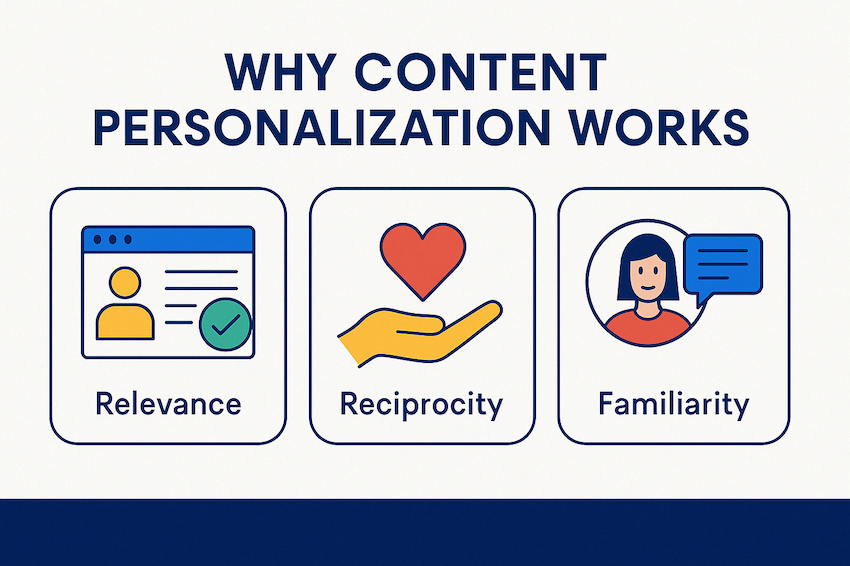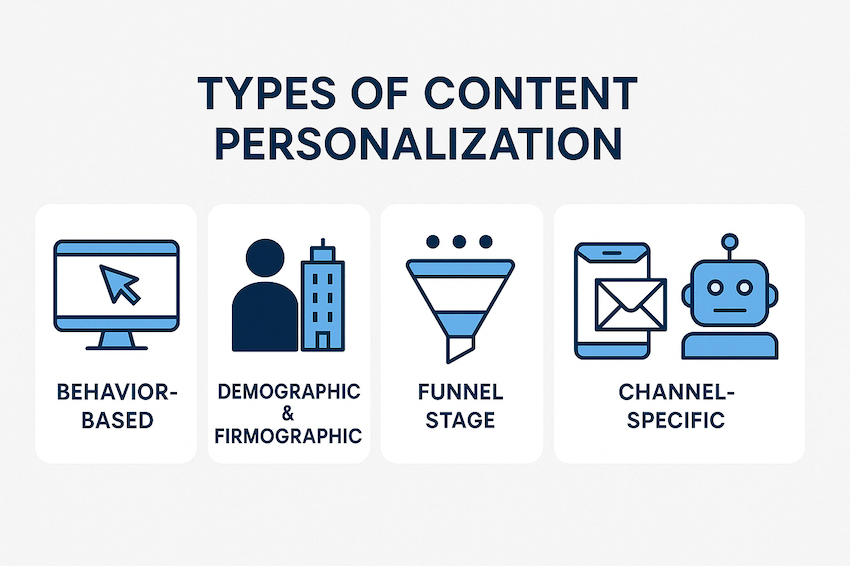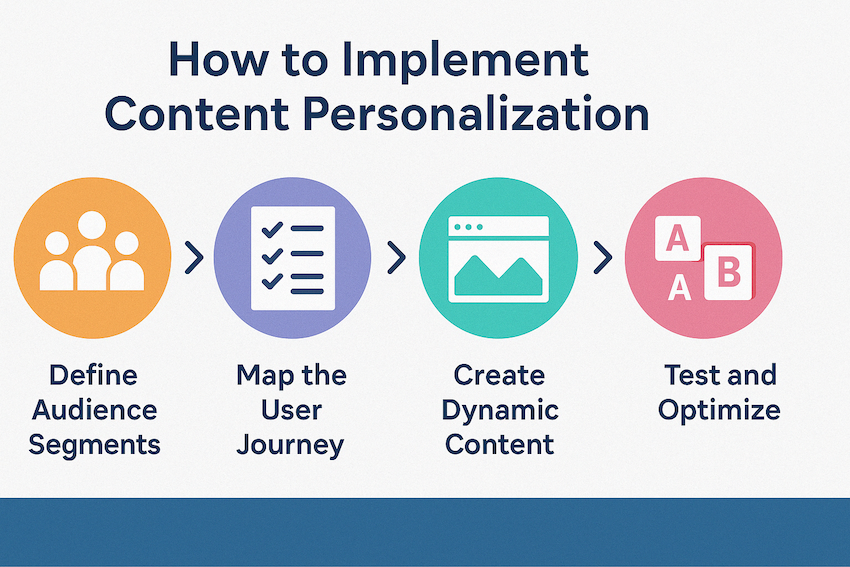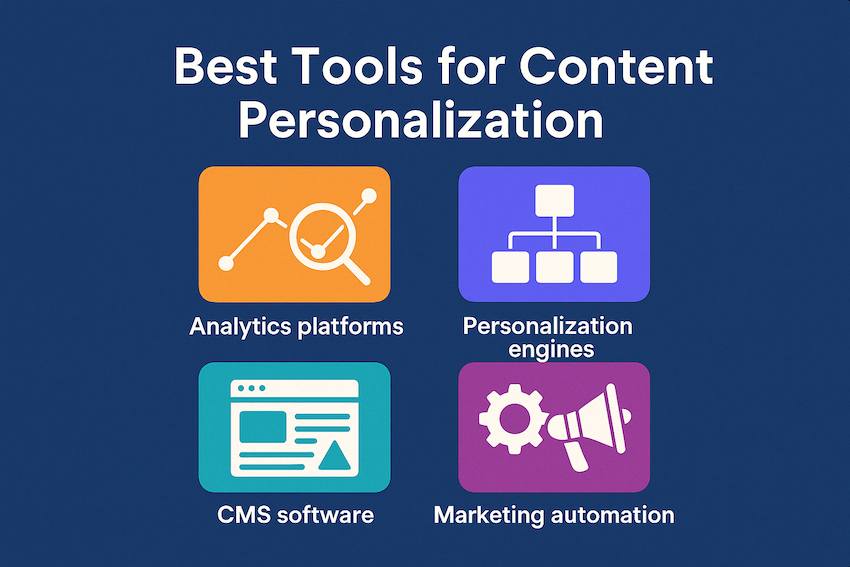
The Ultimate Guide to Content Personalization
Learn how content personalization boosts engagement, drives conversions, and builds loyalty. This guide covers strategies, tools, and real-world examples to help you personalize like top brands.
In a digital world overflowing with generic content, personalization has become a powerful means of cutting through the noise. Content personalization refers to tailoring content to individual users based on their behaviors, preferences, and data profiles. It allows marketers and businesses to deliver more relevant, timely, and engaging experiences that resonate on a personal level.
According to a report by Epsilon, 80% of consumers are more likely to purchase from a brand that offers personalized experiences. Another study by Salesforce found that 52% of consumers expect offers always to be personalized. Whether you're a SaaS marketer, e-commerce manager, or digital strategist, this guide will walk you through everything you need to know about content personalization, what it is, why it works, how to implement it, and what to avoid.
What Is Content Personalization?
Content personalization is the process of tailoring digital content to match a user's specific needs and interests. This is often done using data points such as browsing history, location, purchase behavior, and other relevant information.
Personalization vs. Customization
While both aim to improve user experience, personalization is automated and based on user data, while customization is user-initiated. Think of Netflix suggesting shows based on your watch history versus you manually selecting a genre to browse.
Types of Personalization
- Behavioral: Based on actions like clicks, page views, and time spent on content.
- Demographic: Tailored to user traits such as age, gender, occupation, or location.
- Contextual: This depends on real-time context, such as device type, browser, time of day, or geographic region.
- Psychographic: Based on values, interests, and attitudes gathered through surveys or engagement.

Why Content Personalization Works
Content personalization isn’t just a marketing tactic; it taps into fundamental human psychology. When people see content that speaks directly to their needs and preferences, they feel understood and valued, and are more likely to engage.
Key Benefits
- Increased Engagement: Personalized emails have 29% higher open rates and 41% higher click-through rates.
- Higher Conversion Rates: Targeted content can boost sales by up to 20%, especially in e-commerce and SaaS industries.
- Improved Customer Retention: Users who feel understood and valued are more likely to return and recommend your brand.
- Shorter Sales Cycles: Personalization can guide prospects through the funnel more efficiently with relevant touchpoints.
Why Personalization Drives Results:
- Relevance: Personalized content ensures that users only see what matters to them, increasing attention and interest.
- Reciprocity: When brands make an effort to deliver value, users are more likely to reciprocate with loyalty, engagement, and purchases.
- Familiarity: Repeated, personalized experiences build recognition and trust, making users more comfortable with interacting and making purchases.
Top brands like Amazon, Netflix, and Spotify have set the standard for personalization, and today's consumers expect the same customized experiences from every digital touchpoint.
Real-World Examples
- Amazon: Suggests products based on previous searches and purchases, making the shopping experience intuitive.
- Spotify: Curates weekly playlists like Discover Weekly based on user listening habits.
- Netflix: Uses viewer data to recommend content thumbnails and titles that resonate with individual users.

Types of Content Personalization
Mastering the various types of content personalization is crucial for developing strategies that scale and yield meaningful results. By matching the right approach to your audience and goals, you can create more relevant, engaging experiences at every touchpoint.
Behavior-Based Personalization
Behavior-based personalization leverages real-time and historical user actions to deliver highly relevant content experiences. By monitoring behavioral data, such as browsing patterns, page views, click behavior, content consumption, search queries, cart additions, and engagement metrics, you can tailor experiences that feel intuitive and personalized.
You can use behavior-based personalization to:
- Serve Product Recommendations: Suggest products or services based on previous browsing history, search terms, or purchase behaviors, similar to how Amazon suggests "Customers also bought" options.
- Show Dynamic CTAs: Display different calls-to-action based on a user's level of engagement or interaction history. For example, new visitors may see a "Learn More" call-to-action (CTA), while returning visitors receive a "Request a Demo" prompt.
- Trigger Personalized Follow-Up Emails: Send customized emails based on specific actions, such as abandoned carts, webinar attendance, or viewing product categories. These emails can reignite interest and guide users back into the conversion funnel.
- Tailor Onsite Content: Dynamically update website banners, product pages, or blog recommendations based on a user's past interactions, ensuring the most relevant and timely messaging is always presented.
- Drive Retargeting Campaigns: Serve targeted ads to users based on their previous site activity, resulting in higher click-through rates and more efficient ad spend.
Behavior-based personalization enables you to respond to users’ intent signals in real-time, creating seamless and satisfying journeys that boost engagement, conversions, and brand loyalty.
Demographic and Firmographic Personalization
Demographic and firmographic personalization utilizes static user data to craft highly relevant messaging, content, and offers tailored to the characteristics of your users or the type of organization they represent.
- Demographic Data: Attributes such as age, gender, income level, education, and geographic location enable marketers to personalize experiences that align with the user's background and life stage. For instance:
- Serve regional promotions tied to local events or holidays.
- Highlight different product features based on age group preferences.
- Adjust the language and tone to suit the cultural nuances of the geographic region.
- Firmographic Data: In B2B marketing, firmographics encompass attributes such as company size, industry, annual revenue, and job title. Tailor your messaging by:
- Offering different solutions for small businesses versus enterprise clients.
- Customizing case studies and testimonials to match the prospect’s industry.
- Highlighting different pricing tiers or feature sets depending on company scale and needs.
By layering demographic and firmographic insights into your personalization efforts, you can craft messaging that feels specifically tailored to each audience segment, thereby enhancing both engagement and conversion potential.
Funnel-Stage Personalization
Funnel-stage personalization focuses on delivering content that aligns with a user's current stage in their buying journey. Each stage requires a different approach to meet user expectations, guide decision-making, and maintain momentum.
- Top of Funnel (TOFU) — Awareness: Users are becoming aware of a need or problem for the first time. Personalize by offering value-driven, educational content such as:
- Blog posts, eBooks, and beginner guides addressing everyday challenges.
- Informational webinars or explainer videos.
- Interactive quizzes or assessments that help users self-diagnose their needs.
- Middle of Funnel (MOFU) — Consideration: Users are evaluating potential solutions. Personalization here should build trust and position your offering as the best choice by providing:
- In-depth case studies relevant to their industry or pain point.
- Whitepapers or comparison guides showcasing advantages.
- Personalized nurture sequences based on earlier interactions.
- Bottom of Funnel (BOFU) — Decision: Users are ready to choose a solution. Personalization at this stage should minimize friction and drive conversion with:
- Product demos tailored to their use case.
- Personalized pricing pages, offers, or discounts.
- ROI calculators and testimonials that validate the purchase decision.
When content matches the user's stage of intent, it reduces confusion, builds confidence, and accelerates the path to conversion. Funnel-stage personalization ensures you're always providing the right message at the right time.
Channel-Specific Personalization
Channel-specific personalization focuses on delivering tailored experiences across different marketing platforms. Each channel offers unique opportunities to tailor messaging and content to the user’s context, engagement history, and preferences.
- Email: Use dynamic content blocks to personalize subject lines, body text, and CTAs based on user behavior, preferences, or lifecycle stage. Personalized recommendations, content updates, and segmentation-based campaigns can dramatically increase engagement.
- Website: Personalize homepage banners, product recommendations, and pop-ups for returning visitors based on their previous behavior or interests. Deliver different value propositions depending on traffic source or engagement level.
- Social Media: Retarget users with specific ads based on pages they visited, products they viewed, or content they engaged with. Create custom audiences to deliver hyper-relevant ad campaigns.
- Podcasts: Personalize podcast promotion by recommending episodes based on listener interests or past behavior. Dynamic ad insertions can offer tailored promotions based on the user’s location, device, or demographic profile.
- Newsletters: Segment your newsletter lists to deliver customized editions based on subscriber interests, signup source, or engagement patterns. Personalize article recommendations, event invites, or product highlights inside each email to boost relevance and retention.
By aligning your content strategy with each channel’s unique personalization capabilities, you ensure that users receive consistent, highly relevant experiences wherever they engage with your brand.
AI & Predictive Personalization
AI-driven personalization enables marketers to anticipate user needs and deliver content or offers even before the user explicitly requests them. By analyzing large datasets of historical and real-time behavior, AI can surface trends, detect patterns, and predict future actions with remarkable accuracy.
Here’s how AI-powered personalization enhances your strategy:
- Proactively Recommend Content: Based on browsing history, engagement patterns, and similar user behaviors, AI can suggest articles, products, or next steps that feel naturally tailored to each user.
- Automate Personalization at Scale: Instead of manually segmenting users or setting static rules, AI dynamically adjusts messaging, offers, and creative assets in real-time for thousands of individual users simultaneously.
- Optimize Send Times and Formats: AI tools can predict the best times to send emails, notifications, or ads for each user based on their previous interaction patterns, maximizing open rates and click-through rates.
ConversionWax takes personalization even further by operating in real-time. As soon as a user engages with your site or content, ConversionWax detects their behaviors—such as time on page, clicks, and traffic source—and dynamically adjusts the experience to match their intent. Whether it's changing a call-to-action, displaying different product recommendations, or personalizing offers based on user signals, ConversionWax ensures that every visitor receives the most relevant and timely content possible without delays or manual intervention.
This real-time responsiveness doesn't just improve engagement—it also shortens the customer journey, increases conversion rates, and builds a stronger sense of connection between the user and your brand.

How to Implement Content Personalization
Here’s a step-by-step framework to personalize your content effectively:
1. Define Audience Segments
Effective personalization starts with understanding who you are speaking to. Segment your audience based on behavior, demographics, interests, traffic source, and stage in the buyer journey. Consider:
- Email Subscribers: Differentiate by engagement level (e.g., new signups vs. long-time readers), interests, or campaign interactions.
- Paid Traffic: Segment users based on the ad they clicked, targeting parameters (e.g., demographics, intent), or landing page behavior.
- Affiliate Traffic: Create personalized experiences tailored to the referring affiliate, matching messaging to the affiliate's audience positioning.
- Returning Customers: Recognize loyal customers by offering exclusive content, upsells, or rewards tailored to their purchase history and preferences.
- Geographic Locations: Customize messaging, offers, and content based on a user's location, taking into account regional events, time zones, and language preferences.
Building refined segments ensures that each user receives a more tailored and relevant experience from their very first touchpoint.
2. Map the Buyer Journey
Outline the needs, questions, and goals users have at each stage of their journey, from awareness to decision. A deep understanding of the buyer's mindset at each phase enables you to deliver hyper-relevant, timely content that guides them forward.
- Awareness Stage: Users are becoming aware that they have a problem or need. Their goal is to gather information. Personalization here should focus on educational content, blog posts, how-to guides, and industry insights that position your brand as a trusted resource.
- Consideration Stage: Users are exploring different solutions. They compare brands, read reviews, and seek in-depth information. Personalized webinars, case studies, comparison pages, and targeted nurture emails are most effective in addressing their specific concerns and showcasing your unique value.
- Decision Stage: Users are ready to choose a solution. They need final proof and reassurance. Personalized offers, free trials, consultations, testimonials, and ROI calculators can push them across the finish line.
Mapping these stages with tailored content ensures your personalization efforts meet users exactly where they are, driving better engagement and higher conversions.
3. Collect and Analyze Data
To implement effective content personalization, gathering accurate and actionable user data is critical. Leverage a combination of analytics, behavioral tracking, and direct feedback to build detailed audience profiles.
Use tools like:
- Google Analytics: Track user behavior, traffic sources, page interactions, and conversion paths to understand how visitors engage with your site.
- CRM Platforms (e.g., Salesforce, HubSpot): Manage customer data, segment audiences based on lifecycle stage, and monitor interactions across touchpoints.
- Heatmaps (e.g., Hotjar, Microsoft Clarity): Visualize where users click, scroll, and spend time on your site to identify areas for optimization and personalization opportunities.
- Surveys and Polls (e.g., SurveyMonkey): Collect direct feedback on user preferences, needs, and satisfaction levels to inform your content and personalization strategies.
Combining data (analytics and heatmaps) with insights (CRM notes and survey responses) allows you to deliver hyper-targeted, relevant experiences that reflect real user intent and behavior.
4. Choose the Right Tools
Building an effective personalization strategy requires a robust tech stack that supports dynamic content delivery, audience segmentation, and unified customer profiles. Here's what your personalization toolkit should include:
- A CMS with Dynamic Content Capabilities: Your content management system should allow you to create smart, modular content blocks that can adjust based on user behavior, profile data, or segmentation rules. Platforms like WordPress, Webflow, and Adobe Experience Manager enable the creation of personalized experiences at scale.
- An Email Marketing Platform with Advanced Segmentation: Choose a platform like ActiveCampaign, Klaviyo, or Mailchimp that supports dynamic content in emails, list segmentation, behavior-triggered automations, and audience personalization. Personalized email flows nurture leads more effectively through the funnel.
- A Customer Data Platform (CDP) for Unified Profiles: Implement a CDP like Segment, Treasure Data, or Salesforce Customer 360 to collect, organize, and activate customer data across all touchpoints. A unified view ensures consistent personalization, no matter which channel the customer engages with.
- Additional Tools: Consider adding personalization engines like ConversionWax for A/B testing and behavioral analytics tools to enhance further your ability to personalize at scale.
The right combination of tools ensures your personalization efforts are data-driven, scalable, and capable of delivering a seamless user experience across every channel.
5. Create Dynamic Content
Building flexible, adaptive content is essential to delivering true personalization. Instead of crafting static, one-size-fits-all assets, create modular content blocks that can be swapped, adjusted, or displayed based on who is viewing them.
Dynamic content can be adapted using:
- User Segments: Show different headlines, images, or calls-to-action based on audience traits like industry, interests, or buying behavior.
- Behavioral Triggers: Personalize experiences based on real-time actions such as pages viewed, downloads completed, or products abandoned.
- Funnel Stage: Serve specific content aligned with the user's stage in their journey—top-of-funnel users may see educational resources. At the same time, bottom-of-funnel visitors receive pricing details or offers.
- Traffic Source: Adjust messaging for visitors arriving from email, paid ads, organic search, or affiliate links to match their expectations and prior touchpoints.
- Geographic and Demographic Data: Modify visuals, language, and promotions to align with a user’s location, time zone, or demographic profile.
Examples of dynamic content include smart CTAs, personalized landing pages, adaptive email templates, and location-specific banners. By investing in a dynamic content strategy, you not only improve user experience but also increase engagement, conversion rates, and customer satisfaction.
6. Test and Optimize
Personalization is not a "set it and forget it" strategy. Continuous testing and optimization are crucial for refining your efforts and ensuring that your content resonates with each audience segment.
Start by A/B testing key elements, such as headlines, visuals, calls-to-action (CTAs), and personalization logic. Even subtle changes, such as rephrasing a call-to-action (CTA) or adjusting the tone of a headline, can significantly impact engagement and conversion rates.
Pay special attention to imagery. Showing the right image to the right user at the right time can dramatically elevate emotional connection, relevance, and response rates. For example, a returning customer might resonate more with a "thank you" image showcasing loyalty rewards, while a product feature highlight may be more persuasive to a first-time visitor. Geographic and demographic cues should also influence the visuals; a winter-themed banner may engage users in colder climates, while a summer-themed visual may appeal more to those in warmer regions.
Utilize analytics tools to monitor key performance metrics, including click-through rates, time spent on page, bounce rates, and conversion funnels. Leverage this data to iterate continuously—test new variations, personalize deeper, and stay aligned with your audience’s evolving needs.
By building a vigorous testing and optimization loop, you not only maximize the impact of your personalization efforts but also future-proof your strategy for long-term success.

Best Tools for Content Personalization
| Tool | Features | Best For |
|---|---|---|
| HubSpot | Smart content, CRM integration | SaaS, B2B |
| Adobe Experience Manager | Enterprise‑level content personalization | Large enterprises |
| Dynamic Yield | Real‑time web personalization | E‑commerce |
| Optimizely | A/B testing, behavioral targeting | Growth teams |
| RightMessage | Website personalization and segmentation | Startups, bloggers |
| Conversionwax | Real Time personalization, conversion optimization | Conversion focused businesses |
Case Studies
Case Study 1: Mid-Sized Fashion Retailer Boosted Conversions by 32% With Geographic Personalization
A mid-sized fashion retailer found itself stuck in a frustrating position. Despite driving solid ad traffic to their Shopify store, their conversion rates were plateauing, especially in certain regions.
Case Study 2: Boosting Demo Signups with Smarter, Time-Sensitive CTAs
A fast-growing SaaS company faced a challenge common in today’s competitive landscape—while their website traffic numbers were impressive, they weren’t translating into demo signups, especially during evening hours.
Case Study 3: Electronics Store Reduced Nighttime Cart Abandonment by 26% Using Time Based Personalization
An electronics retailer running their online store on Magento faced a common but frustrating issue: cart abandonment.
Conclusion
Content personalization is no longer optional; it's a necessity for brands that want to stay relevant, competitive, and deeply connected to their audience. Whether you're just getting started or scaling up your strategy, the key is understanding your audience, leveraging the right tools, and creating dynamic, data-driven content.
References
-
GDPR.eu. General Data Protection Regulation (GDPR) Compliance Guidelines.
-
State of California Department of Justice. California Consumer Privacy Act (CCPA).
-
HubSpot, Adobe Experience Manager, Dynamic Yield, Optimizely, and RightMessage. (2024). Features and Reviews from G2 and Capterra.
-
General industry knowledge from Amazon, Spotify, and Netflix personalization practices widely cited in marketing and UX case studies.
